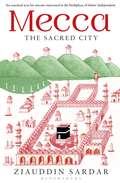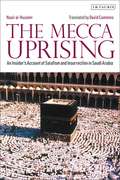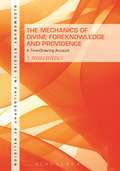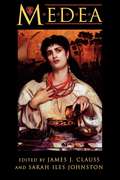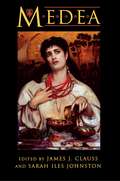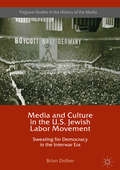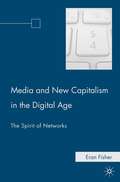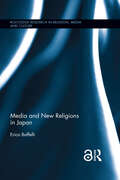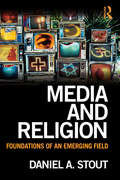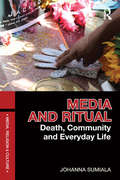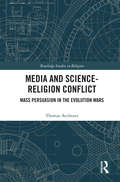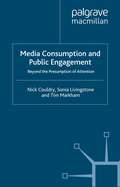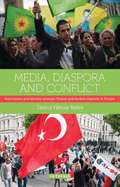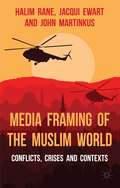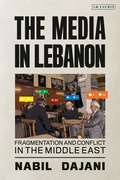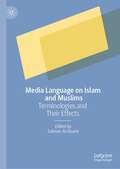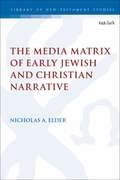- Table View
- List View
Mecca: The Sacred City
by Ziauddin SardarMecca is the heart of Islam. It is the birthplace of Muhammad, the direction towards which Muslims turn when they pray and the site of pilgrimage which annually draws some three million Muslims from all corners of the world. Yet Mecca's importance goes beyond religion. What happens in Mecca and how Muslims think about the political and cultural history of Mecca has had and continues to have a profound influence on world events to this day. In this captivating book, Ziauddin Sardar unravels the significance of Mecca. Tracing its history, from its origins as a 'barren valley' in the desert to its evolution as a trading town and sudden emergence as the religious centre of a world empire, Sardar examines the religious struggles and rebellions in Mecca that have powerfully shaped Muslim culture. Interweaving stories of his own pilgrimages to Mecca with those of others, Sardar offers a unique insight into not just the spiritual aspects of Mecca – the passion, ecstasy and longing it evokes – but also the conflict between heritage and modernity that has characterised its history. He unpeels the physical, social and cultural dimensions that have helped transform the city and also, though accounts of such Orientalist travellers as Richard Burton and Charles Doughty, the strange fascination that Mecca has long inspired in the Western imagination. And, ultimately, he explores what this tension could mean for Mecca's future. An illuminative, lyrical and witty blend of history, reportage and memoir, this outstanding book reflects all that is profound, enlightening and curious about one of the most important religious sites in the world.
The Mecca Uprising: An Insider's Account of Salafism and Insurrection in Saudi Arabia
by Nasir al-HuzaimiOn 20th November 1979, the Salafi Group, led by a charismatic figure named Juhaiman al-Utaibi, seized control of the Sacred Mosque in Mecca, the holiest site in the Muslim World. The Salafi Group was not trying to establish an Islamic state. Instead, its members believed they were players in a prophetic script about the End of Time. After a two-week siege, the Saudi government recaptured the mosque, threw the survivors into prison, and had them publicly executed. The Mecca Uprising offers an insider's account of the religious subculture that incubated the Mecca Uprising, written by a former member of the Salafi Group, Nasir al-Huzaimi. Huzaimi did not participate in the uprising, but he was arrested in a government sweep of Salafi Group members and spent six years in prison. In 2011, he published his memoir, Days with Juhaiman, offering the most detailed picture we have of the Salafi Group and Juhaiman. The Mecca Uprising had profound effects on Saudi Arabia and the Muslim world[DC1] [YG2] . The Saudi government headed off opposition from religious activists and made efforts to buttress the ruling family's legitimacy as the guardians of Islam. Huzaimi's memoir sheds light on the background of this religious and political landscape, and is the most detailed account we have of the Salafi Group and Juhaiman. The English edition is complete with an introduction and annotations prepared by expert David Commins to help readers understand the relevance of the Meccan Uprising [DC3] and how it fits into the history of the Islamic World. [DC1]lower case? Muslim world [YG2]changed to author's suggestion [DC3]Mecca Uprising
The Mecca Uprising: An Insider's Account of Salafism and Insurrection in Saudi Arabia
by Nasir al-HuzaimiOn 20th November 1979, the Salafi Group, led by a charismatic figure named Juhaiman al-Utaibi, seized control of the Sacred Mosque in Mecca, the holiest site in the Muslim World. The Salafi Group was not trying to establish an Islamic state. Instead, its members believed they were players in a prophetic script about the End of Time. After a two-week siege, the Saudi government recaptured the mosque, threw the survivors into prison, and had them publicly executed. The Mecca Uprising offers an insider's account of the religious subculture that incubated the Mecca Uprising, written by a former member of the Salafi Group, Nasir al-Huzaimi. Huzaimi did not participate in the uprising, but he was arrested in a government sweep of Salafi Group members and spent six years in prison. In 2011, he published his memoir, Days with Juhaiman, offering the most detailed picture we have of the Salafi Group and Juhaiman. The Mecca Uprising had profound effects on Saudi Arabia and the Muslim world[DC1] [YG2] . The Saudi government headed off opposition from religious activists and made efforts to buttress the ruling family's legitimacy as the guardians of Islam. Huzaimi's memoir sheds light on the background of this religious and political landscape, and is the most detailed account we have of the Salafi Group and Juhaiman. The English edition is complete with an introduction and annotations prepared by expert David Commins to help readers understand the relevance of the Meccan Uprising [DC3] and how it fits into the history of the Islamic World. [DC1]lower case? Muslim world [YG2]changed to author's suggestion [DC3]Mecca Uprising
The Mechanics of Divine Foreknowledge and Providence: A Time-Ordering Account (Bloomsbury Studies in Philosophy of Religion)
by T. Ryan ByerlyHow exactly could God achieve infallible foreknowledge of every future event, including the free actions of human persons? How could God exercise careful providence over these same events? Byerly offers a novel response to these important questions by contending that God exercises providence and achieves foreknowledge by ordering the times.The first part of the book defends the importance of the above questions. After characterizing the contemporary freedom-foreknowledge debate, Byerly argues that it has focused too narrowly on a certain argument for theological fatalism, which attempts to show that the existence of infallible divine foreknowledge poses a unique threat to the existence of creaturely libertarian freedom. Byerly contends, however, that bare existence of infallible divine foreknowledge cannot threaten freedom in this way; at most, the mechanics whereby this foreknowledge is achieved might so threaten human freedom.In the second part of the book, Byerly develops a model for understanding the mechanics whereby infallible foreknowledge is achieved that would not threaten creaturely libertarian freedom. According to the model, God infallibly foreknows every future event because God has placed the times that constitute the history of the world in primitive earlier-than relations to one another. After defending the consistency of this model of the mechanics of divine foreknowledge with creaturely libertarian freedom, the author applies it to divine providence more generally. A novel defense of concurrentism is the result.
The Mechanics of Divine Foreknowledge and Providence: A Time-Ordering Account (Bloomsbury Studies in Philosophy of Religion)
by T. Ryan ByerlyHow exactly could God achieve infallible foreknowledge of every future event, including the free actions of human persons? How could God exercise careful providence over these same events? Byerly offers a novel response to these important questions by contending that God exercises providence and achieves foreknowledge by ordering the times.The first part of the book defends the importance of the above questions. After characterizing the contemporary freedom-foreknowledge debate, Byerly argues that it has focused too narrowly on a certain argument for theological fatalism, which attempts to show that the existence of infallible divine foreknowledge poses a unique threat to the existence of creaturely libertarian freedom. Byerly contends, however, that bare existence of infallible divine foreknowledge cannot threaten freedom in this way; at most, the mechanics whereby this foreknowledge is achieved might so threaten human freedom.In the second part of the book, Byerly develops a model for understanding the mechanics whereby infallible foreknowledge is achieved that would not threaten creaturely libertarian freedom. According to the model, God infallibly foreknows every future event because God has placed the times that constitute the history of the world in primitive earlier-than relations to one another. After defending the consistency of this model of the mechanics of divine foreknowledge with creaturely libertarian freedom, the author applies it to divine providence more generally. A novel defense of concurrentism is the result.
Medea: Essays on Medea in Myth, Literature, Philosophy, and Art
by James J. Clauss Sarah Iles JohnstonFrom the dawn of European literature, the figure of Medea--best known as the helpmate of Jason and murderer of her own children--has inspired artists in all fields throughout all centuries. Euripides, Seneca, Corneille, Delacroix, Anouilh, Pasolini, Maria Callas, Martha Graham, Samuel Barber, and Diana Rigg are among the many who have given Medea life on stage, film, and canvas, through music and dance, from ancient Greek drama to Broadway. In seeking to understand the powerful hold Medea has had on our imaginations for nearly three millennia, a group of renowned scholars here examines the major representations of Medea in myth, art, and ancient and contemporary literature, as well as the philosophical, psychological, and cultural questions these portrayals raise. The result is a comprehensive and nuanced look at one of the most captivating mythic figures of all time. Unlike most mythic figures, whose attributes remain constant throughout mythology, Medea is continually changing in the wide variety of stories that circulated during antiquity. She appears as enchantress, helper-maiden, infanticide, fratricide, kidnapper, founder of cities, and foreigner. Not only does Medea's checkered career illuminate the opposing concepts of self and other, it also suggests the disturbing possibility of otherness within self. In addition to the editors, the contributors include Fritz Graf, Nita Krevans, Jan Bremmer, Dolores M. O'Higgins, Deborah Boedeker, Carole E. Newlands, John M. Dillon, Martha C. Nussbaum, Christiane Sourvinou-Inwood, and Marianne McDonald.
Medea: Essays on Medea in Myth, Literature, Philosophy, and Art
by Sarah Iles Johnston James J. ClaussFrom the dawn of European literature, the figure of Medea--best known as the helpmate of Jason and murderer of her own children--has inspired artists in all fields throughout all centuries. Euripides, Seneca, Corneille, Delacroix, Anouilh, Pasolini, Maria Callas, Martha Graham, Samuel Barber, and Diana Rigg are among the many who have given Medea life on stage, film, and canvas, through music and dance, from ancient Greek drama to Broadway. In seeking to understand the powerful hold Medea has had on our imaginations for nearly three millennia, a group of renowned scholars here examines the major representations of Medea in myth, art, and ancient and contemporary literature, as well as the philosophical, psychological, and cultural questions these portrayals raise. The result is a comprehensive and nuanced look at one of the most captivating mythic figures of all time. Unlike most mythic figures, whose attributes remain constant throughout mythology, Medea is continually changing in the wide variety of stories that circulated during antiquity. She appears as enchantress, helper-maiden, infanticide, fratricide, kidnapper, founder of cities, and foreigner. Not only does Medea's checkered career illuminate the opposing concepts of self and other, it also suggests the disturbing possibility of otherness within self. In addition to the editors, the contributors include Fritz Graf, Nita Krevans, Jan Bremmer, Dolores M. O'Higgins, Deborah Boedeker, Carole E. Newlands, John M. Dillon, Martha C. Nussbaum, Christiane Sourvinou-Inwood, and Marianne McDonald.
Media and Culture in the U.S. Jewish Labor Movement: Sweating for Democracy in the Interwar Era
by Brian DolberThis book explores the Jewish Left’s innovative strategies in maintaining newspapers, radio stations, and educational activities during a moment of crisis in global democracy. In the wake of the First World War, as immigrant workers and radical organizations came under attack, leaders within largely Jewish unions and political parties determined to keep their tradition of social unionism alive. By adapting to an emerging media environment dependent on advertising, turn-of-the-century Yiddish socialism morphed into a new political identity compatible with American liberalism and an expanding consumer society. Through this process, the Jewish working class secured a place within the New Deal coalition they helped to produce. Using a wide array of archival sources, Brian Dolber demonstrates the importance of cultural activity in movement politics, and the need for thoughtful debate about how to structure alternative media in moments of political, economic, and technological change.
Media and Culture in the U.S. Jewish Labor Movement: Sweating for Democracy in the Interwar Era
by Brian DolberThis book explores the Jewish Left’s innovative strategies in maintaining newspapers, radio stations, and educational activities during a moment of crisis in global democracy. In the wake of the First World War, as immigrant workers and radical organizations came under attack, leaders within largely Jewish unions and political parties determined to keep their tradition of social unionism alive. By adapting to an emerging media environment dependent on advertising, turn-of-the-century Yiddish socialism morphed into a new political identity compatible with American liberalism and an expanding consumer society. Through this process, the Jewish working class secured a place within the New Deal coalition they helped to produce. Using a wide array of archival sources, Brian Dolber demonstrates the importance of cultural activity in movement politics, and the need for thoughtful debate about how to structure alternative media in moments of political, economic, and technological change.
Media and New Capitalism in the Digital Age: The Spirit of Networks
by E. FisherThis book explores the new terrain of network capitalism through the transformations of the discourse on technology. Rather than viewing such discourse as either a true or false reflection of reality, Fisher evaluates the ideological role that technology discourse plays in the legitimation of a new form of capitalism. Based on an extensive empirical analysis, the book argues that contemporary technology discourse at one and the same time promises more personal empowerment through network technology and legitimates a more privatized, flexible, and precarious economic constellations. Such discourse signals a new tradeoff in the political culture of capitalism, from a legitimation discourse which emphasizes the capacity of technology and technique to bring about social emancipation (through equality, stability, and security) to a legitimation discourse which focuses on the capacity of technology to bring about individual emancipation (through individual empowerment, authenticity, creativity, and cooperation). Contrary to the prevailing assumption that sees network technology as liberating from the rigidity and pitfalls of a stifling, Fordist capitalism, the book offers a theoretical framework which sees contemporary technology discourse as an ideology that legitimates the economic, social, and political arrangements of the new capitalism.
Media and New Religions in Japan (Routledge Research in Religion, Media and Culture)
by Erica BaffelliThe Open Access version of this book, available at www.taylorfrancis.com/books/9781135117849, has been made available under a Creative Commons Attribution-Non Commercial-No Derivative 4.0 license. Japanese "new religions" (shinshūkyō) have used various media forms for training, communicating with members, presenting their messages, reinforcing or protecting the image of the leader, and, potentially, attracting converts. In this book the complex and dual relationship between media and new religions is investigated by looking at the tensions groups face between the need for visibility and the risks of facing attacks and criticism through media. Indeed media and new technologies have been extensively used by religious groups not only to spread their messages and to try to reach a wider audience, but also to promote themselves as a highly modern and up-to-date form of religion appropriate for a modern technological age. In 1980s and early 1990s some movements, such as Agonshū , Kōfuku no Kagaku, and Aum Shinrikyō came into prominence especially via the use of media (initially publications, but also ritual broadcasts, advertising campaigns, and public media events). This created new modes of ritual engagement and new ways of interactions between leaders and members. The aim of this book is to develop and illustrate particular key issues in the wider new religions and media nexus by using specific movements as examples. In particular, the analysis of the interaction between media and new religions will focus primarily on three case studies predominantly during the first period of development of the groups.
Media and New Religions in Japan (Routledge Research in Religion, Media and Culture)
by Erica BaffelliThe Open Access version of this book, available at www.taylorfrancis.com/books/9781135117849, has been made available under a Creative Commons Attribution-Non Commercial-No Derivative 4.0 license. Japanese "new religions" (shinshūkyō) have used various media forms for training, communicating with members, presenting their messages, reinforcing or protecting the image of the leader, and, potentially, attracting converts. In this book the complex and dual relationship between media and new religions is investigated by looking at the tensions groups face between the need for visibility and the risks of facing attacks and criticism through media. Indeed media and new technologies have been extensively used by religious groups not only to spread their messages and to try to reach a wider audience, but also to promote themselves as a highly modern and up-to-date form of religion appropriate for a modern technological age. In 1980s and early 1990s some movements, such as Agonshū , Kōfuku no Kagaku, and Aum Shinrikyō came into prominence especially via the use of media (initially publications, but also ritual broadcasts, advertising campaigns, and public media events). This created new modes of ritual engagement and new ways of interactions between leaders and members. The aim of this book is to develop and illustrate particular key issues in the wider new religions and media nexus by using specific movements as examples. In particular, the analysis of the interaction between media and new religions will focus primarily on three case studies predominantly during the first period of development of the groups.
Media and Religion: Foundations of an Emerging Field
by Daniel A. StoutThis text examines the history, theory, cultural context, and professional aspects of media and religion. While religion has been explored more fully in psychology, sociology, anthropology, and the humanities, there is no clear bridge of understanding to the communication discipline. Daniel A. Stout tackles this issue by providing a roadmap for examining this understudied area so that discussions about media and religion can more easily proceed. Offering great breadth, this text covers key concepts and historical highlights; world religions, denominations, and cultural religion; and religion and specific media genres. The text also includes key terms and questions to ponder for every chapter, and concludes with an in-class learning activity that can be used to encourage students to explore the media–religion interface and review the essential ideas presented in the book. Media and Religion is an ideal introduction for undergraduate students in need of a foundation for this emerging field.
Media and Religion: Foundations of an Emerging Field
by Daniel A. StoutThis text examines the history, theory, cultural context, and professional aspects of media and religion. While religion has been explored more fully in psychology, sociology, anthropology, and the humanities, there is no clear bridge of understanding to the communication discipline. Daniel A. Stout tackles this issue by providing a roadmap for examining this understudied area so that discussions about media and religion can more easily proceed. Offering great breadth, this text covers key concepts and historical highlights; world religions, denominations, and cultural religion; and religion and specific media genres. The text also includes key terms and questions to ponder for every chapter, and concludes with an in-class learning activity that can be used to encourage students to explore the media–religion interface and review the essential ideas presented in the book. Media and Religion is an ideal introduction for undergraduate students in need of a foundation for this emerging field.
Media and Ritual: Death, Community and Everyday Life (Media, Religion and Culture)
by Johanna SumialaThis wide-ranging and accessible book offers a stimulating introduction to the field of media anthropology and the study of religious ritual. Johanna Sumiala explores the interweaving of rituals, communication and community. She uses the tools of anthropological enquiry to examine a variety of media events, including the death of Michael Jackson, a royal wedding and the transgressive actions which took place in Abu Ghraib, and to understand the inner significance of the media coverage of such events. The book deals with theories of ritual, media as ritual including reception, production and representation, and rituals of death in the media. It will be invaluable to students and scholars alike across media, religion and anthropology.
Media and Ritual: Death, Community and Everyday Life (Media, Religion and Culture)
by Johanna SumialaThis wide-ranging and accessible book offers a stimulating introduction to the field of media anthropology and the study of religious ritual. Johanna Sumiala explores the interweaving of rituals, communication and community. She uses the tools of anthropological enquiry to examine a variety of media events, including the death of Michael Jackson, a royal wedding and the transgressive actions which took place in Abu Ghraib, and to understand the inner significance of the media coverage of such events. The book deals with theories of ritual, media as ritual including reception, production and representation, and rituals of death in the media. It will be invaluable to students and scholars alike across media, religion and anthropology.
Media and Science-Religion Conflict: Mass Persuasion in the Evolution Wars (Routledge Studies in Religion)
by Thomas AechtnerThis book examines why the religion-science skirmishes known as the Evolution Wars have persisted into the 21st century. It does so by considering the influences of mass media in relation to decision-making research and the Elaboration Likelihood Model, one of the most authoritative persuasion theories. The book’s analysis concentrates on the expression of cues, or cognitive mental shortcuts, in Darwin-sceptic and counter-creationist broadcasts. A multiyear collection of media generated by the most prominent Darwin-sceptic organizations is surveyed, along with rival publications from supporters of evolutionary theory described as the pro-evolutionists. The analysed materials include works produced by Young Earth Creationist and Intelligent Design media makers, New Atheist pacesetters, as well as both agnostic and religious supporters of evolution. These cues are shown to function as subtle but effective means of shaping public opinion, including appeals to expertise, claims that ideas are being censored, and the tactical use of statistics and technical jargon. Contending that persuasive mass media is a decisive component of science-religion controversies, this book will be of keen interest to scholars of Religion, Science and Religion interactions, as well as researchers of Media and Communication Studies more generally.
Media and Science-Religion Conflict: Mass Persuasion in the Evolution Wars (Routledge Studies in Religion)
by Thomas AechtnerThis book examines why the religion-science skirmishes known as the Evolution Wars have persisted into the 21st century. It does so by considering the influences of mass media in relation to decision-making research and the Elaboration Likelihood Model, one of the most authoritative persuasion theories. The book’s analysis concentrates on the expression of cues, or cognitive mental shortcuts, in Darwin-sceptic and counter-creationist broadcasts. A multiyear collection of media generated by the most prominent Darwin-sceptic organizations is surveyed, along with rival publications from supporters of evolutionary theory described as the pro-evolutionists. The analysed materials include works produced by Young Earth Creationist and Intelligent Design media makers, New Atheist pacesetters, as well as both agnostic and religious supporters of evolution. These cues are shown to function as subtle but effective means of shaping public opinion, including appeals to expertise, claims that ideas are being censored, and the tactical use of statistics and technical jargon. Contending that persuasive mass media is a decisive component of science-religion controversies, this book will be of keen interest to scholars of Religion, Science and Religion interactions, as well as researchers of Media and Communication Studies more generally.
Media Consumption and Public Engagement: Beyond the Presumption of Attention (Consumption and Public Life)
by N. Couldry S. Livingstone T. MarkhamDemocracy is based on the belief that the media gets the attention of voters. But is this plausible in an age of multiplying media, disillusionment with the political system and time-scarcity? This book addresses this question, and charts experiences of 'public connection'.
Media, Diaspora and Conflict: Nationalism and Identity amongst Turkish and Kurdish Migrants in Europe (International Library of Migration Studies)
by Janroj Yilmaz KelesFor migrant communities residing outside of their home countries, various transnational media have played a key role in maintaining, reviving and transforming ethnic and religious identities. A vital element is how media outlets report and represent ethno-national conflict in the home country. Janroj Yilmaz Keles here examines how this plays out among Kurdish and Turkish communities in Europe. He offers an analysis of how Turkish and Kurdish migrants in Europe react to the myriad mediated narratives. A vital element is how media outlets report and represent the ethno-national conflict between the Turkish state and the Kurdish PKK.Janroj Yilmaz Keles here offers an examination of how Turkish and Kurdish migrants in Europe react to the myriad narratives that arise. Taking as his starting point an analysis of the nature of nationalisms in the modern age, Keles shows how language is often a central element in the struggle for hegemony within a state. The media has become a site for the clash of representations in both Turkish and Kurdish languages, especially for those based in the diaspora in Europe. These 'virtual communities', connected by television and the internet, in turn influence and are influenced by the way the conflict between the Turkish state and subaltern Kurds is played out, both in the media and on the ground.By looking at first, second and third generations of Turkish and Kurdish populations in Europe, Keles highlights the dynamics of migration, settlement and integration that often depend on the policies of each settlement country. Since these settlement states often see the proliferation of such media as an impediment to integration, Media, Diaspora and Conflict offers timely analysis concerning the nature of diasporas and the construction of identity.
Media Framing of the Muslim World: Conflicts, Crises and Contexts
by John Martinkus H. Rane J. EwartMedia Framing of the Muslim World examines and explains how news about Islam and the Muslim world is produced and consumed, and how it impacts on relations between Islam and the West. The authors cover key issues in this relationship including the reporting on war and conflict, terrorism, asylum seekers and the Arab Spring.
Media in Lebanon: Fragmentation and Conflict in the Middle East
by Nabil DajaniLebanese society is famously, and even notoriously, fragmented, along both class and sectarian lines. Here, Nabil Dajani looks at how this societal division impacts on the nature of the mass media in Lebanon. Implementing the wider theory that the structure and content of mass media is unique to the society within which it operates, he looks at how Lebanese media have often helped to sustain the sectarian divisions within Lebanese society. Dealing with newspapers, radio and television as well as new and emerging forms of communication, such as the internet, social media websites and blogs, he examines how the media both reflect societal realties as well as the ways they influence social consciousness. Beginning with an analysis of the socio-political context of modern-day Lebanon, Dajani critically examines the historical and current realities of the media in this country.
Media in Lebanon: Fragmentation and Conflict in the Middle East (Library Of Modern Middle East Studies Ser. #Vol. 136)
by Nabil DajaniLebanese society is famously, and even notoriously, fragmented, along both class and sectarian lines. Here, Nabil Dajani looks at how this societal division impacts on the nature of the mass media in Lebanon. Implementing the wider theory that the structure and content of mass media is unique to the society within which it operates, he looks at how Lebanese media have often helped to sustain the sectarian divisions within Lebanese society. Dealing with newspapers, radio and television as well as new and emerging forms of communication, such as the internet, social media websites and blogs, he examines how the media both reflect societal realties as well as the ways they influence social consciousness. Beginning with an analysis of the socio-political context of modern-day Lebanon, Dajani critically examines the historical and current realities of the media in this country.
Media Language on Islam and Muslims: Terminologies and Their Effects
by Salman Al-AzamiThis book brings together contributions from ten academics and a commentary from a Muslim community leader on how the British media represent some of the most important terminologies related to Islam and Muslims. It takes a nuanced approach to language within Muslims in the media research by focusing on terminologies. Each contributor in this volume focused on one terminology and its associated words to show how the representation of these terminologies have major implications on the lives of British Muslims. The book also includes some key recommendations on the usage of these terms from the Media Style Guide of the Centre for Media monitoring - a research organisation of the Muslim Council of Britain. This book’s link with the Muslim community can be a step towards new approaches in this field where academics will engage with communities and practitioners to ensure better impact of their academic works. This book will be of interest to students, scholars and practitioners in a range of fields, including Journalism, Media and Communication Studies, English Language and Linguistics, Sociology, Cultural and Religious Studies.
The Media Matrix of Early Jewish and Christian Narrative (The Library of New Testament Studies)
by Nicholas ElderThis volume compares two seemingly dissimilar ancient texts, the Gospel of Mark and Joseph and Aseneth. The former is a product of the nascent Jesus movement and influenced by the Greco-Roman Bioi (“Lives”). It details the life, ministry, death, and resurrection of a wandering Galilean. The latter is a Hellenistic Jewish narrative influenced by Jewish novellas and Greek romances. It expands the laconic account of Joseph's marriage to Aseneth in Genesis 41 into a full-fledged love and adventure story. Generically, theologically, and concerning content the two texts are quite different.Nonetheless, Mark and Joseph and Aseneth exhibit a number of remarkable similarities. This book suggests that Mark and Joseph and Aseneth are alike because of their medium and mode of composition. Each was composed via dictation. They are “textualized oral narratives.” As such they represent one instantiation of the complex relationship between orality and textuality in early Judaism and Christianity.
